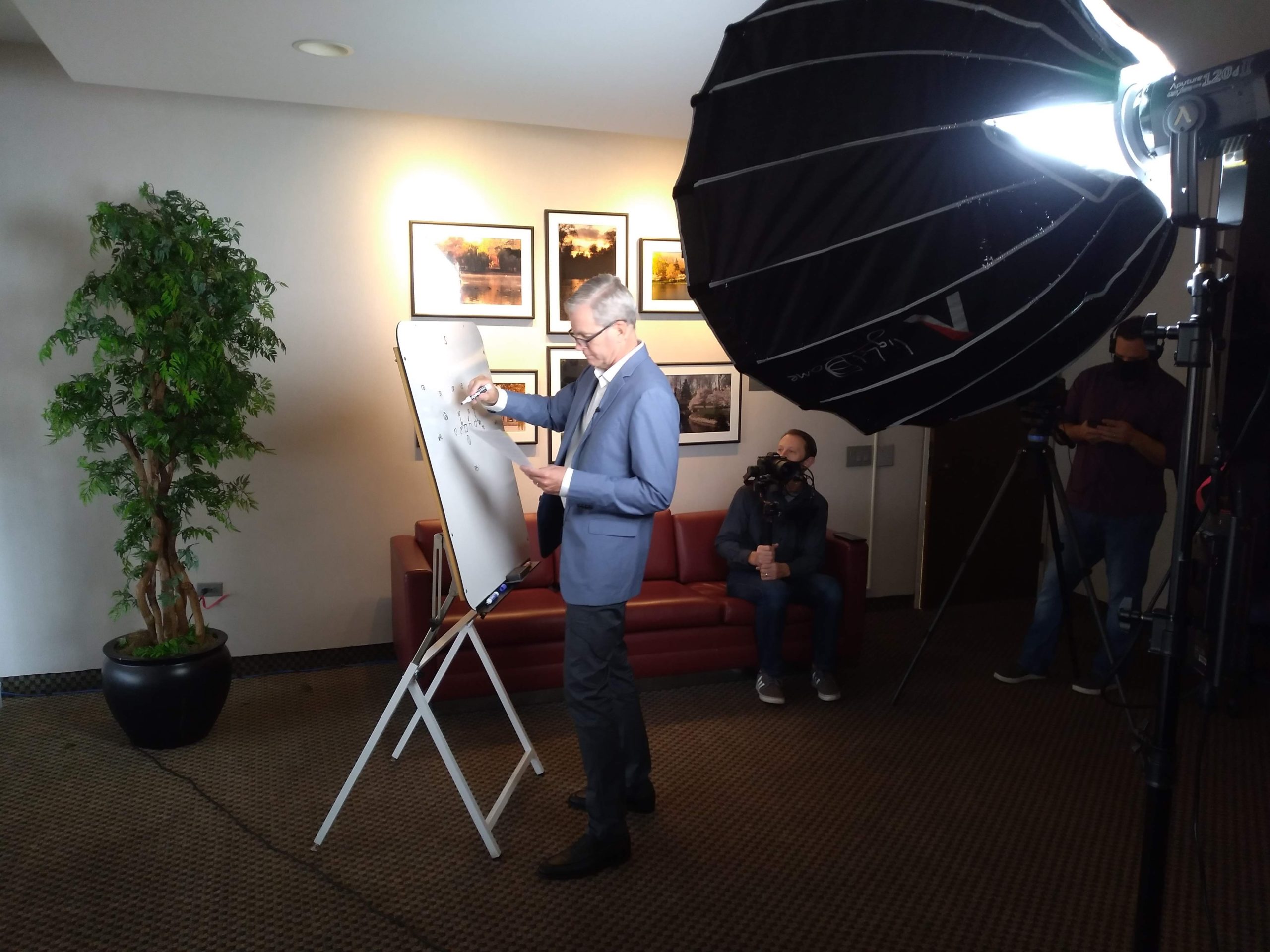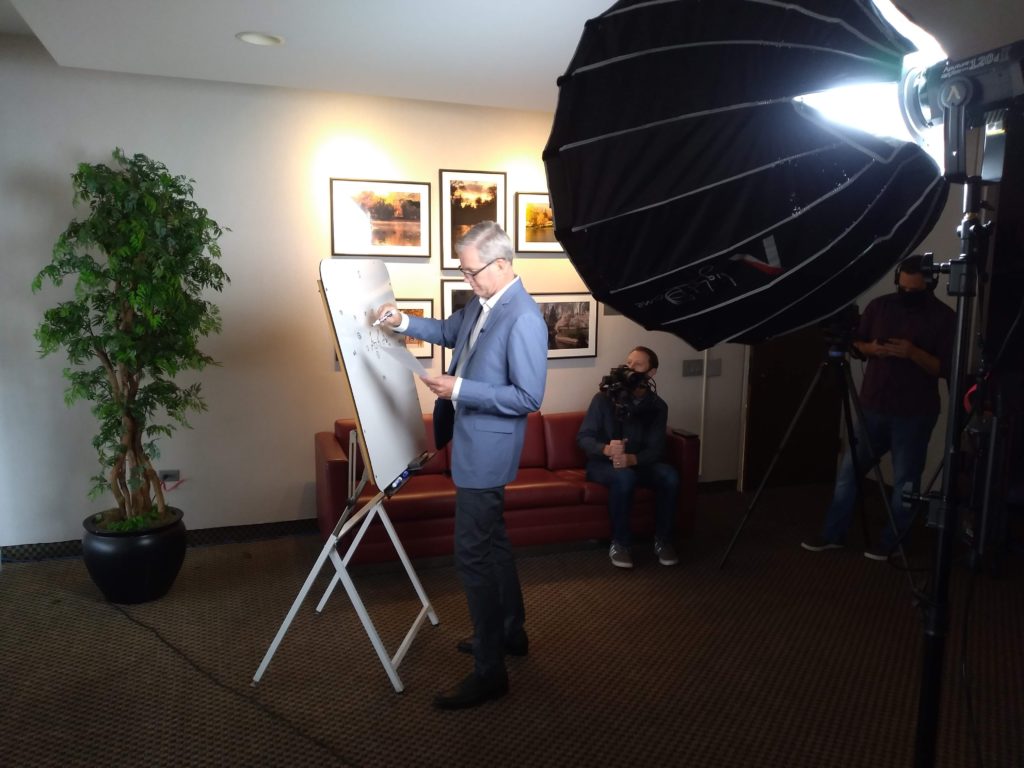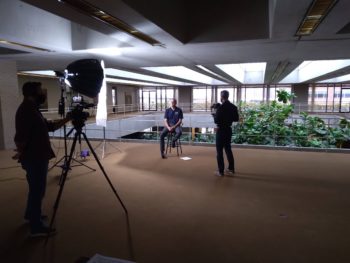How The Buffalo News used social videos on the Buffalo Bills to increase engagement
Brian Connolly and Geoff Nason, The Buffalo News,
A behind-the-scenes look at Mark Gaughan shooting his X's and O's Bills analysis (Courtesy of The Buffalo News)
Here’s an idea to steal and adapt: Take a beat that your newsroom owns – in this case, the Buffalo Bills – and leverage your journalists’ expertise on the subject, paired with an appropriate platform like social video, to build reader engagement and generate sponsorships.This is a series on Better News to a) showcase innovative/experimental ideas that emerge from the Knight-Lenfest Newsroom Initiative and b) share replicable tactics that benefit the news industry as a whole. This “win” comes from Brian Connolly, The Buffalo News’ vice president of innovation and business development, and Geoff Nason, Gusto manager at The News, which participated in the Poynter Table Stakes program in 2018-19.
You can also hear all about it on the It’s All Journalism podcast.
Question: What communities do you serve and what can you tell us about the history of your organization?
Answer: The Buffalo News has been a provider of news and information to Western New York since 1880. We connect with readers in New York State’s eight westernmost counties and beyond through a seven-day print newspaper; region-leading website at BuffaloNews.com; suite of email newsletters; and active social media accounts.
The majority of our readers live or work in the city of Buffalo and its suburbs. The region is often described as post-industrial, with an economy that is still adapting to a shift away from large-scale manufacturing employment. There is nothing that unites the region or serves as a more identifiable icon than the Buffalo Bills, who started play in the American Football League in 1960.
Q: What problem were you trying to solve, and why was solving the problem strategically important for your organization?
A: Following the natural conclusion of a partnership that had run its course in which we had our sports reporters appearing on local TV segments, we took the opportunity to create something new that:
- Was prime for advertising revenue, given the appetite of clients to be paired with certain types of video.
- Grew our digital audience by adding a unique content offering in a popular, but crowded, space – Buffalo Bills coverage.
- Used the proper medium to correctly tell the story. In this case, it was video and animation on social media to best convey the X’s and O’s type of analysis that sports reporter Mark Gaughan excels at.
- Stood as great content marketing, showing off our expertise that makes us unique.

A behind-the-scenes look at Mark Gaughan shooting his X’s and O’s Bills analysis (Courtesy of The Buffalo News)
Q: How is this approach related to Table Stakes (e.g. one of the 7 Table Stakes and/or an outgrowth of the Knight-Lenfest initiative, etc.)?
A: The PlayAction project relates directly to Table Stake No. 2 (“Publish on the platforms used by your targeted audiences”) and Table Stake No. 6 (“Partner to expand your capacity and capabilities at lower and more flexible cost”).
Specifically, with regards to Table Stake No. 2, with a rough idea of what we wanted our product to be, we abandoned the type of thinking we would have been saddled with in the past: “Will pre-roll ads generate enough revenue? How will readers find this on our website? How can we make this among our most-viewed videos?” Instead, we viewed this as a succinct video series primed for our social audience. Future development of the product continued with this top of mind. We felt this allowed for us to not only reach a new audience, but it would increase the reach of our sponsor.
With regards to Table Stake No. 6, we realized this would require a specialized type of production, requiring some expertise we did not have. We moved forward with Uplifter Video, a company we had previously worked with on marketing projects, to deliver the animations and high-level production that took PlayAction where we needed it to be.
Q: How did you go about creating a video series that has organic growth and engagement?
A: By designing PlayAction for social consumption, we knew organic growth would be essential. As we monitored our numbers week to week, Danielle Ossher, our creative director in marketing, and Tiffanie Woods, our social media marketing manager, emphasized the steady organic growth we saw.
The videos typically were about two minutes long, with the first 30 seconds setting the stage for what Mark was going to break down, followed by a 30-second commercial and then a minute of X’s and O’s animation with Mark providing the voiceover.
From a newsroom perspective, we were able to produce content in a way we had never done before, paving the way for us to connect with a new audience. Other sports reporters chimed in with anticipation:
I never cease to be amazed by Mark’s technical/analytical perspective on football. This is going to be a really fun feature this season. @gggaughan @TBNSports https://t.co/odoF6rXdVX
— Rachel Lenzi ???? (@rachelmlenzi) September 8, 2021
I’m so excited for this!! Can’t wait for @gggaughan’s weekly breakdowns: https://t.co/E9gLSKnYG9
— katherine fitzgerald (@kfitz134) September 8, 2021
Q: What are your goals around the series and how is success measured?
A: Success was realized in various ways. For starters, we benefited by building a product that brought in advertising revenue.
In terms of audience reach, the videos were paired with a weekly PlayAction newsletter and written PlayAction digital features. Via API’s Metrics For News, these features regularly placed among our most engaging content.
Across social media, the PlayAction campaign surpassed 1 million impressions and 700,000 video views.
Q: What didn’t work?
A: Due to the nature of how the project came together, we didn’t have much flexibility to make in-season adjustments. The sponsorship was sold for the entire Bills regular season to Russell’s Steakhouse, and we had a fairly strict production schedule to stick to.
However, we were able to reassess the project and tweak it prior to a special edition we produced before the Bills’ AFC Divisional Round playoff game against the Kansas City Chiefs. We felt the best part of PlayAction was the animation, so we wanted to get right into it. We settled on a much shorter intro, and dropped the video length from about 2 minutes to 45 seconds.
We felt the mid-video ad would be more effective with sponsor placement solely on the intro and outro screens. We also saw an area for additional audience reach on Instagram, so we filmed that particular episode in a vertical format with an eye toward that platform.
View this post on Instagram
Q: What makes this different from other Buffalo Bills content you’ve produced in the past?
A: It was designed with a social audience in mind, for starters. Plus, the animations allowed for a new way for Mark to convey his deep knowledge of the game to readers.
Another difference, not just in terms of Bills content, was the collaborative effort across various departments. At the outset, members of our newsroom and creative team in marketing worked together. Mark bought in, adapted quickly and made the whole thing work. He wrote each script and was a natural on camera.
Danielle had been – and continues to – oversee a highly successful News marketing project called Dig In, Buffalo! She served as a great resource for Geoff Nason, as the newsroom’s liaison on PlayAction. Her experience with Dig In guided Geoff from the outset, as far as building a timeline and what to expect at a filming session. Danielle and Geoff talked each week about PlayAction.
Brian Connolly arranged a few check-ins throughout the year where Danielle, Tiffanie and Geoff would share data, updates and ideas. Those meetings enabled us to quickly pivot in strategy and approach for the postseason video we tailored for Instagram.
Q: How do you go about marketing the series and tailoring it to specific platforms?
A: To optimize organic performance, Tiffanie performed an audit of The Buffalo News channels to find the best time to post the videos, which varied by platform, and designated times for community management to engage with followers.
We also utilized the newsroom in engaging with posts, largely by retweeting and quote-tweeting on Twitter to organically reach a broader audience. Via our paid efforts, Tiffanie created a tailored custom audience PlayAction appealed to – highly knowledgeable and niche football fans who were interested in the breakdowns and historical knowledge Mark brought to the videos.
Q: What advice would you give to others who try to do this?

Jason Holler (left, behind tripod) and Mark Blaszak (right, holding other camera) from Uplifter Video take video of Mark Gaughan. (Courtesy of The Buffalo News)
A: During an initial brainstorming session, Brian made clear to Executive Sports Editor Josh Barnett and Geoff that we shouldn’t focus on what we can’t do – due to NFL rights agreements, or not having technical capabilities to do animation, or not having the budget to shoot a new episode each week.
But instead, we needed to think outside the box and focus on what we wanted the product to be, then work backward from that.
This philosophy resulted in us achieving something that quickly became a success, and this approach has become a model for other projects we have pursued.
Q: Is there anything else you’d like to add?
A: The collaboration between our newsroom, marketing and advertising teams was critical to this project’s success.
From the newsroom perspective, we made a concerted effort to avoid defensiveness and a sense of needing to protect the product. When Danielle and Tiffanie recommended tweaking the approach of the playoff edition, we didn’t flinch. There was no, “Why change what works?” Instead it was, “We completely trust their judgment on this, so let’s do it.”